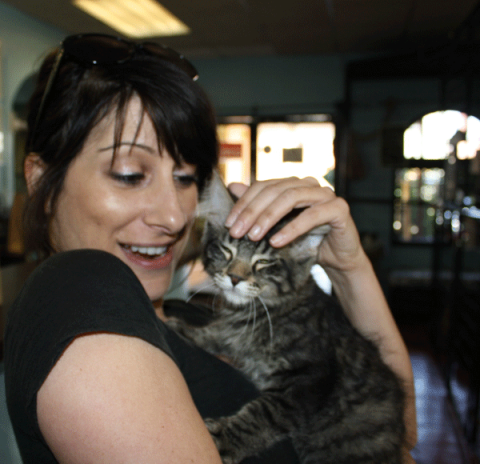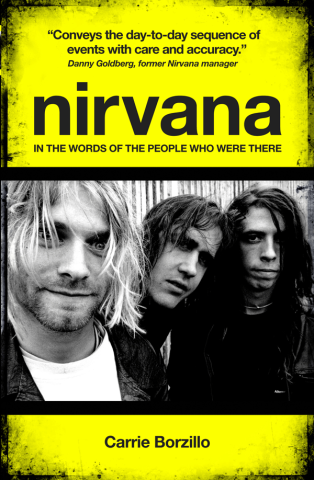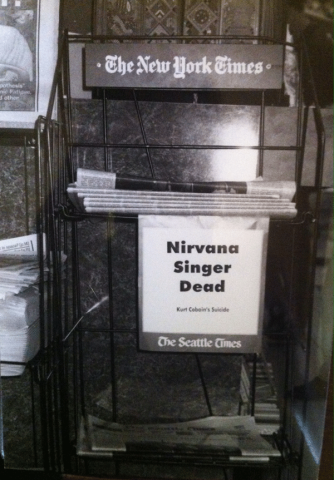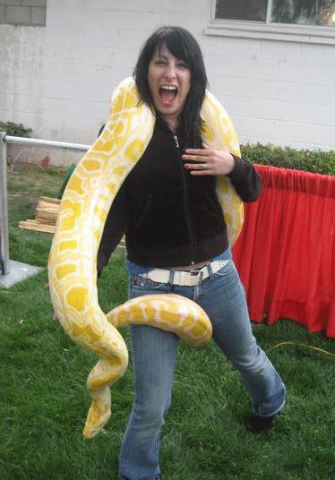
The charity copies must be purchased directly from Borzillo, via her website, and cost $25 (to U.S.) and $35 (international), inc. shipping.
It’s not the first time she has been charitable, of course; it’s just the first time she has paired it with her work. She is a self-confessed cat freak who adopted both her kitties — named after Sex and the City’s Carrie Bradshaw and Aidan — from shelters and for a while volunteered at the Wildlife Waystation, which houses lions, bears, hyenas, oh my. But having a life filled with rock ‘n’ roll, interviews with musicians and television stars, and yourself becoming a called upon expert for radio and TV is way too much fun — and far from philanthropic. She’s just been building this amazing career the past 25 years.
Like a page out of Almost Famous, Borzillo started her music journalism career in her hometown of Connecticut when she was just 17, covering the local music beat, and went on to write for Billboard, Spin and RollingStone.com. In addition to music, she branched into other entertainment coverage for People, E! Online, Us Weekly, Teen People, CosmoGirl! and Hit Parader. In 2009, she won Best Music Journalist at the National Association of Record Industry Professionals (NARIP).
Following her debut book on Nirvana, Borzillo — then married to Chris Vrenna of Nine Inch Nails and Marilyn Manson — penned 2008’s Cherry Bomb: The Ultimate Guide to Becoming a better Flirt, a Tougher Chick, and a Hotter Girlfriend, and Living Life Like a Rock Star. In 2010, she co-authored Tera Patrick’s Sinner Takes All: A Memoir of Love and Porn.
Borzillo is presently contemplating the topic of her fourth book and filming scenes for a reality show she can’t yet divulge. Meanwhile, she wants to try and add a charity component to some of the things she does in the future from books to garage sales.
Borzillo talked to Samaritanmag about what kind of book she would write now about Cobain, how the stigma regarding depression and mental illness has changed and how she feels it should be addressed in schools. She also talked about her love of animals and volunteering at a shelter where she had a rather bloody task.

“Absolutely. And even when Kurt first died of course there was a focus on suicide, but there was a lot of emphasis on him being a junkie and addicted to heroin. People didn’t delve too much into, ‘Well, why is someone a drug addict?’ It’s not because they’re just partying and having fun. I mean, that is to help them through the pain; that’s really beneath [it]. He was deeply depressed and had a very difficult childhood and suffered from depression from a very early age and people just want to focus on the drug addiction and all the drama, but it’s just so sad when you think you know what’s underneath it.
“His suicide in particular was just, my god, so violent. I mean, a shotgun blast to your head, it doesn’t get any worse than that. And, at the time, suicide was mentioned, but nobody really took that extra step to be like, ‘Okay, we need to bring more awareness to mental health issues in general and especially starting from a very young age.’
“If he was diagnosed properly as being depressed and gotten proper treatment would things have turned out differently? That said, he was a child of the ‘70s and in a weird little town of Aberdeen in that area of Washington. If you are depressed, they don’t take you to a psychiatrist. And today it’s more okay, but it’s still not fully there. I still see so many instances of a troubled child not getting the proper treatment and people still have this stigma attached to depression.
“There’s commercials every two seconds on TV for depression and anxiety ads and medications and stuff, which is great; it draws attention to it, but what I think really needs to happen at the grade school level is that we need to teach mental health the way we teach phys-ed and our intellectual health. There’s classes for everything except, literally, our emotional development. That’s something that is still, in a way, so overlooked and there’s still this stigma; people are embarrassed to say they’re depressed, but it’s a problem like drug addiction; it’s a disease. You’re not embarrassed to say you have cancer; you shouldn’t be embarrassed to say you have these other emotional problems.
“This organization, the American Foundation for Suicide Prevention, does a lot to bring awareness, not just to suicide but mental health in general. I just really always admired what they did and I personally have had personal experiences with depression and anxiety — whether it was myself or people in my life — and drug addiction, people in my circle. As I get older and wiser, it just takes on more meaning to me, what happened to Kurt. It just breaks my heart. And I didn’t want to capitalize on his 20th anniversary by just selling a book, I had to do something that helped others instead of just my pocketbook.”
You talked to 50 people. Do you recall if some people wanted to talk to you about Kurt’s depression and suicide or wished they could’ve done something had they known or the types of things that you do go through when you lose someone to suicide?
“They were really more okay talking about the drug addiction and not the underlying reasons of the drug addiction. Drug addiction is definitely a symptom of a deeper rooted problem, like, with him, depression. And so it was all about the drugs, all about the drugs, all about the drugs, almost in a shaming way, too., you know?
“But the people who were really close to him — the one interview in particular that I can think of is Danny Goldberg, he as a former manager and they tried, they tried, and a lot of people involved, including him, have this sense of guilt in a way. But they couldn’t have tried any harder, though. They did interventions; he had been in and out of rehab. To me, Kurt was just kind of doomed. I never really saw it having a happy ending.

We are more so now, especially in the last couple of years. There have been major campaigns highlighting depression and suicide. Do you think you’d approach this book differently today or is there another book to be written?
“Oh yeah. You’ve got it. Anytime you finish anything, especially how many years later, you definitely think, ‘Oh, I could do this; I could do that.’ Nothing’s ever perfect. Anyone who creates anything would think the same way. If I went back and did it now — actually I don’t want to say if I went back and did it now; I really want to push my publisher to let me update it with new interviews for the 25th anniversary, because I wrote the book in ‘99 and I got responses and had to pitch people for interviews, via fax! Not email, fax! And it was really hard tracking down people too because social media was not present.
“Right now, I can friend these people on my Facebook. I have like three of Nirvana’s ex drummers on my Facebook now and I’m like, ‘Where were you when I was trying to reach you in 99?’ So if I could update the book for the 25th anniversary — and they haven’t said yes to this yet but I’m going to really push it — I would re-interview a lot of people that I interviewed the first time, and I’d also approach people who said no the first time because it was too soon. It was only five years after his death; it was still raw; it was still fresh; people still feared Courtney love, you know what I mean? And then there’s others; there's new people.
“I would definitely — especially with me personally being a little bit more evolved as far as knowing a little bit more about therapy and depression and anxiety and drug addiction and suicidal thoughts and all that with personal experiences — go back to tackle it, to dig deeper into what was going on with Kurt emotionally every step of the way, not just talking about, ‘Oh, what was it like backstage at this concert?’ but ‘What was Kurt’s mood like? Did he seem depressed? Did you ever talk to him about serious things?’ There are so many questions related to that that I would love to be able to ask now and I think it would help a bit and shed more light, be like the inner workings of the depressed mind and how he got to the point where he was at with the drug addiction and the suicide. So yeah, oh my god, absolutely.”

“Animals, for sure. What I personally donate to is mental health, drug addiction, and animals. I’ve done volunteer work myself with the Wildlife Waystation, this refuge for exotic and wild animals, like when the circus breaks down and they have no place to put the lions and tigers they put them out there. So I’ve actually shoveled shit and done real hands-on work for those animals.
“I haven’t volunteered for them for a couple years, but I did for like a year or so — I still will donate money to them — I would spend an entire Wednesday up there. I was on the bloodsicle team. In the summer, we'd make frozen popsicles out of the blood from the runoff of the meat used to feed the animals and give them to the canines (wolves, coyotes, hyenas), felines (lions, tigers, pumas etcetera.) and bears as a cool treat. And, oh my god, they just loved it. It was so satisfying to see these animals just so excited when we’d walk up with our little stash of bloodsicles. It was so goth. I had to pick the most goth team to be on at the animal sanctuary.
“And then with ASPCA [American Society for the Prevention of Cruelty to Animals] — I’m a cat freak, absolutely; my cat is stepping on my computer right now — I always adopt [my cats] and donate wherever I can. Even at the check out at [pet supply store] Petco, when they ask, ‘Do you want to donate a dollar?’ I say ‘yes’ every single time, so I try to do my bit there [Petco has a Foundation that’s in partnership with over 8000 non-profit animal welfare groups]. And I’m on my way to becoming 100 percent vegetarian, but I’m not there yet.
“It’s just a constant process of evolving and trying to be more socially aware and less selfish. As I get older, I realize that my career has just been so self-serving you know? I never helped anybody writing about Kurt Cobain. I helped the band. But I’m trying really hard to filter in some things that aren’t just for me, me, me, for causes that I really care about.”
As a music journalist too, that’s why I started Samaritanmag, actually.
“Even just little things. Like when I have a garage sale at my house, it’ll be a portion of the sale goes to whatever shelter I feel like helping out at that minute. So, it’s a little bit, but I think they add up. And it’s not always about the money bringing aid to the organization; it’s really about the awareness and, hopefully, to be inspiring other people, but I feel like I’m never doing enough and I wanted to do more. You can make something so commercial and make it so it’s going to a good cause. I think going forward for every book, I’ll figure out a way to donate something to an organization.”
Air Jordan 1 Retro High OG NRG White/Rust Pink-Black To Buy